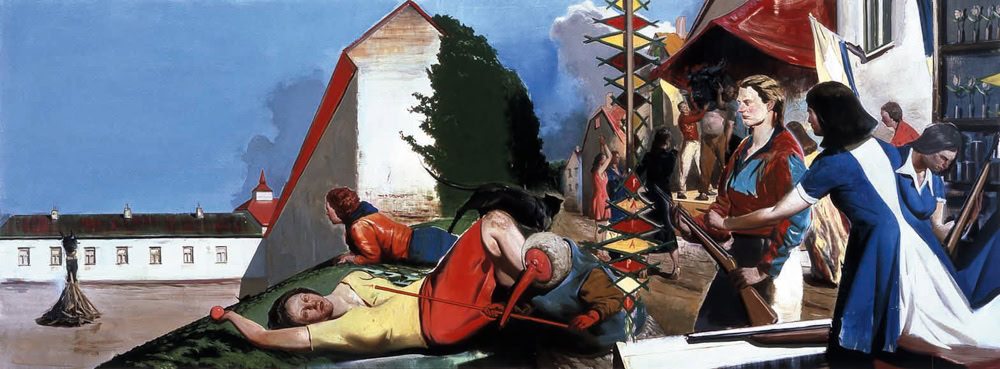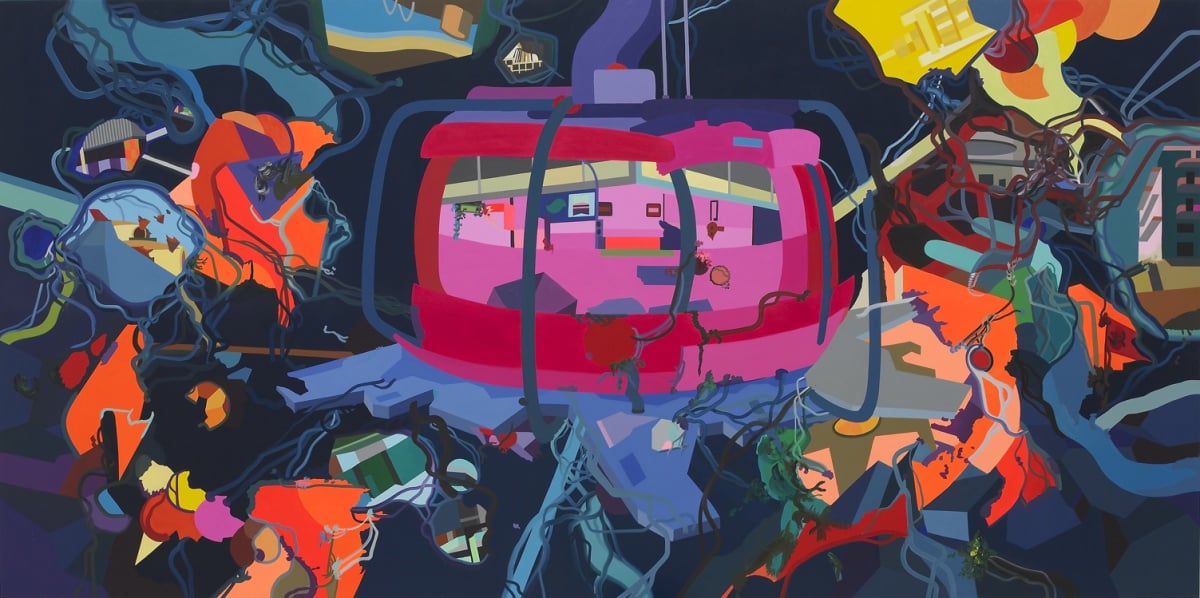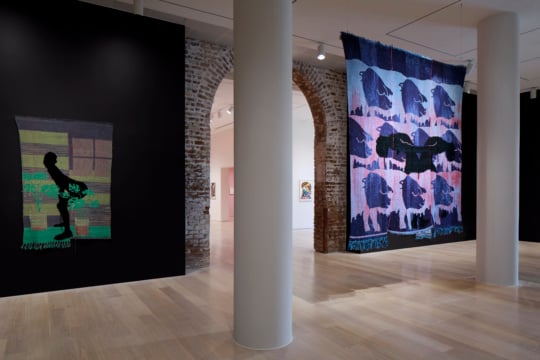
A wide-ranging new exhibition of contemporary painting at the Frist Art Museum asks big questions about the medium and humankind, and the futures they may share together. “Chaos and Awe: Painting for the 21st Century” asserts that painting will continue to play a central role in envisioning, narrating and illuminating human culture in this new century. From the ochre animals galloping across ancient cave walls to the radical developments of European modernism to Franz Ackermann’s massive, fluorescent-hued Untitled (yet) that dominates the exhibition’s entrance, painting may be nearly as deeply human a behavior as speech or singing. And after touring this exhibition one gets the feeling that no matter what the future holds for our planet and our species, if there are humans in the future we will know them by their painting.
In a trilogy of previous shows – “Paint Made Flesh” (2009), “Fairy Tales, Monsters, and the Genetic Imagination” (2012), and “Phantom Bodies: The Human Aura in Art” (2015) – curator Mark Scala focused on representations of the human body in contemporary art. Here, he scales up from the individual body to consider the collective, global body of our species, and to examine “the destabilizing effects of such 21st-century forces as globalism, mass migration, radical ideologies, and complex technologies.” That said, for all of far-reaching conversations he engages, Scala announces the theme of each gallery only with brief didactic panels. To its credit, this show feels laid out more like a thoughtful curatorial poem than a formally categorized narrative.

Neo Rauch’s Warten auf die Barbaren (Waiting for the Barbarians) references J.M. Coetzee’s novel of the same name. The book imagines an imperial fort in a colonial outpost where the officials hear rumors of a native revolt. Preemptive torture and imprisonment follow as paranoia and power lash out at a threat that never comes to pass. The expansive canvas holds an entire wall near the start of the exhibition, and its depiction of armed colonials overlooking a courtyard where a figure appears to be burning at the stake is a brutal visual distillation of Coetzee’s themes.
Rauch’s painting is rendered in bold blue, green and red, and, when viewed from a distance, the pictorial elements are arranged in something akin to stripes on a national flag. Its place in Scala’s “Shadows of History” gallery speaks to the way we humans write our actual histories while simultaneously re-imagining them in our visual art and literature. It also points specifically to a Western historical narrative punctuated by genocide, slavery and imperialism.

While Rauch’s piece is practically monumental, the highlight of the “Collisions” section is a suite of small works by Iranian artist Rockni Haerizadeh. But a Storm is Blowing from Paradise features photographs of war, riots, and protests that the artist found online. Haerizadeh prints the images and then paints on them, often depicting police and invading soldiers with fierce animal heads that are as satirical as they are savage.
The “Interzone” section of the show is named for a 1989 collection of short works by author William S. Burroughs, as well as a fictional setting based on Tangier in Burroughs’s Naked Lunch. This section reflects on the way in which global travel and migration affect language, traditions and cultural assumptions. Travel transforms us, and whether a person or a people are running from something or towards something they often find themselves changed upon arrival. One of the most formally gorgeous paintings in the show is Contact by Iranian-born Ali Banisadr. A cacophony of purples and pinks hovers on a blue background, and the bonkers energy in the artist’s crisscrossing lines remind us that even in the friendliest meetings between different cultures dynamic and unpredictable explosions of inspiration, adaptation and imitation are often the result.

James Perrin is the only Nashville artist included in the exhibition. His Semiosis on the Sea was inspired by a photograph of a woman sitting on a beach, but the figure is all but obliterated by Perrin’s countless transparent layers of paint which he meticulously models in intricate Photoshop constructions before his canvases are even stretched. The result here is a deep field of blackness interrupted by a two v-shaped rainbow designs and a massive island of paint chips from scraped frome Perrin’s palette clinging to the center of the canvas. The overall effect reads like an interdimensional object breaking through the sky above the ocean, and it packs a welcome wallop of physical and emotional impact in a show full of works that mostly seek to convey ideas.
Korean-born Atlanta artist Jiha Moon’s Pied de grue reads like the calm, balanced aftermath of Banisadr’s work. Moon creates her paintings in the shape of Korean paper fans and covers them with dense compositions that interweave traditional Korean animal symbols like cranes and cats with Western motifs like Twitter’s blue bird logo and the occasional yellow smiley face. The pairing of ancient and contemporary, Korean and American, is an example of the new cultural fabrics that are constantly being rewoven at the overlaps of peoples, places and times.
“Chaos and Awe” includes a section on “Virtual Worlds.” In his catalogue essay, Scala writes “what can be achieved today through painting looks very circumscribed compared to what is possible in other more immersive and interactive media,” and he makes the gutsy leap of including virtual reality displays and even two video art pieces in this exhibition of “painting.” The most successful of these is Rachel Rossin’s interactive VR installation, which let’s viewers have painterly interactions in an immersive environment inspired by the artist’s own studio.

While I admire Scala’s willingness to expand on the idea of what might be considered painting here in this breathless now, he gives pigments and binders the last word in his “Everything” gallery, where imaginal works attempt to capture the invisible energies humans might encounter in future spaces that can only be imagined today. The most successful works here are a trio of Anoka Faruqee’s perception-bending, op-art inspired works. The artist uses a specially designed trowel to create intricate successions of thread-thin lines in interference patterns that make these works seem to undulate into and out of the gallery wall. These are the works that most fulfill the “awe” part of the exhibition’s title, offering an analog of the experience of the sublime, which Scala explains as “being terrified or overwhelmed by the unfathomable nature of God and the cosmos.” Amen.




